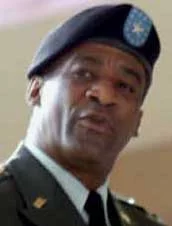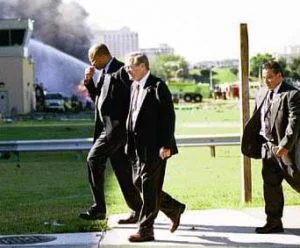Captain Charles J Leidig was asked by Brigadier General Montague Winfield the day before 9/11 to take over his responsibilities. Leidig “assumed duties as the Deputy for Command Center Operations in the J3 Directorate of the Joint Staff… responsible for the maintenance, operation, and training of watch teams for the National Military Command Center (NMCC).” In testimony given to the 9/11 Commission, Leidig explained that “the Command Center then became a focal point for coordinating information flow… I convened a conference called a Significant Event Conference. And what that does is that brings leadership and combatant commanders into the conference to start discussing what actions should be taken or might be taken… I… [controlled] the conference that gets all these folks on the phone.” Leidig was not reprimanded and was later promoted in 2004 to Admiral.
8:30 a.m. September 11, 2001: Rookie in Command of the NMCC
Captain Charles Leidig. [Source: US Navy] Captain Charles Leidig, the deputy for Command Center operations at the NMCC, takes over temporarily from Brigadier General Montague Winfield and is effectively in charge of NMCC during the 9/11 crisis. Winfield had requested the previous day that Leidig stand in for him on September 11. Leidig had started his role as Deputy for Command Center Operations two months earlier and had qualified to stand in for Winfield just the previous month. Leidig remains in charge from a few minutes before the 9/11 crisis begins until about 10:30 a.m., after the last hijacked plane crashes. He presides over an important crisis response teleconference that has a very slow start, not even beginning until 9:39 a.m. [9/11 COMMISSION, 6/17/2004; 9/11 COMMISSION, 6/17/2004]
(Shortly After 9:03 a.m.) September 11, 2001: NMCC Commander Concludes US is Under Attack, Yet Does Not Retake Charge of Center

[Source: US Army]Brigadier General Montague Winfield, commander of the National Military Command Center (NMCC), the Pentagon’s emergency response center, later says, “When the second aircraft flew into the second tower, it was at that point that we realized that the seemingly unrelated hijackings that the FAA was dealing with were in fact a part of a coordinated terrorist attack on the United States.” [ABC NEWS, 9/14/2002] For unknown reasons, Winfield had stepped down from his usual position at 8:30 a.m., and allowed Captain Charles Leidig, a rookie on the job who had only been qualified about a month, to temporarily take his place as deputy director for operations in the NMCC (see 8:30 a.m. September 11, 2001). [9/11 COMMISSION, 6/17/2004] Post 9/11 news reports will give the impression that Winfield remained in the NMCC throughout the course of the attacks, and was aware of the unfolding events. None of them will mention him ever having left the center. [CNN, 9/4/2002; ABC NEWS, 9/11/2002] Yet, despite concluding that the US is suffering a “coordinated terrorist attack,” Winfield allows Leidig to continue as his stand-in, and does not take over from him and resume charge of the center until shortly after Flight 93 has crashed. This would presumably be around 10:15-10:30 a.m. [9/11 COMMISSION, 6/17/2004]
The National Miilitary Command Center, inside the Pentagon. [Source: National Military Command Center]Captain Charles Leidig is temporarily in command of the National Military Command Center (NMCC), “the military’s worldwide nerve center.” In response to the attacks on the World Trade Center, he convenes a conference call. [CNN, 9/4/2002; 9/11 COMMISSION, 6/17/2004] Telephone links are established between the NMCC located inside the Pentagon (but on the opposite side of the building from where the explosion will happen), Canada’s equivalent Command Center, Strategic Command, theater commanders, and federal emergency-response agencies. At one time or another, President Bush, Vice President Cheney, Defense Secretary Rumsfeld, key military officers, leaders of the FAA and NORAD, the White House, and Air Force One are heard on the open line. [AVIATION WEEK AND SPACE TECHNOLOGY, 6/3/2002; 9/11 COMMISSION, 6/17/2004] NORAD command director Captain Michael Jellinek claims this call was initiated “at once” after the second WTC tower was hit. [AVIATION WEEK AND SPACE TECHNOLOGY, 6/3/2002] However, the 9/11 Commission concludes it starts at 9:29 a.m. According to the commission, it begins as an all-purpose “significant event” conference. But at 9:30, Leidig states that it has just been confirmed that Flight 11 is still airborne and is heading toward Washington, DC. (This incorrect information apparently arose minutes earlier during a conference call between FAA centers (see 9:21 a.m. September 11, 2001).) In response to this erroneous report, the significant event conference is ended at around 9:34. It then resumes at about 9:37 as an air threat conference call, which lasts for more than eight hours. [9/11 COMMISSION, 6/17/2004; 9/11 COMMISSION, 7/24/2004, PP. 37] This is broadcast over a loudspeaker inside the NMCC. [US NEWS AND WORLD REPORT, 8/31/2003] Brigadier General Montague Winfield, who later takes over from Leidig in charge of the NMCC, says, “All of the governmental agencies that were involved in any activity going on in the United States at that point, were in that conference.” [ABC NEWS, 9/11/2002] The call continues right through the Pentagon explosion; the impact is not felt within the NMCC. [CNN, 9/4/2002] However, despite being in the Pentagon when it is hit, Defense Secretary Rumsfeld doesn’t enter the NMCC or participate in the call until 10:30 a.m. (see (10:30 a.m.) September 11, 2001).
9:39 a.m. September 11, 2001: Defense Secretary Rumsfeld Is Wanted at Pentagon Teleconference but Cannot Be Reached

Defense Secretary Donald Rumsfeld returns from the Pentagon crash site “by shortly before or after 10:00 a.m.” Then he has “one or more calls in my office, one of which was with the president,” according to his testimony before the 9/11 Commission. [9/11 COMMISSION, 3/23/2004] The commission later concludes that Rumsfeld’s call with President Bush has little impact: “No one can recall any content beyond a general request to alert forces.” The possibility of shooting down hijacked planes is not mentioned. [9/11 COMMISSION, 6/17/2004] Rumsfeld then goes to the Executive Support Center (ESC) located near his office, arriving there at around 10:15 a.m. In the ESC already are Stephen Cambone, Rumsfeld’s closest aide, Larry Di Rita, Rumsfeld’s personal chief of staff, and Torie Clarke, the assistant secretary of defense for public affairs. Rumsfeld had instructed Di Rita and Clarke to go to the ESC and wait for him there when they’d come to his office soon after the second WTC tower was hit at 9:03 a.m. (see (After 9:03 a.m.) September 11, 2001). Presently, Rumsfeld gives them their first confirmation that a plane hit the Pentagon, saying, “I’m quite sure it was a plane and I’m pretty sure it’s a large plane.” According to Clarke, he pulls out a yellow legal pad and writes down three categories, “by which his thinking would be organized the rest of the day: what we needed to do immediately, what would have to be underway quickly, and what the military response would be.” [CLARKE, 2006, PP. 221-222; COCKBURN, 2007, PP. 5-6] The Executive Support Center has secure video facilities, and while there, Rumsfeld participates in the White House video teleconference. This is the video conference that counterterrorism “tsar” Richard Clarke claims Rumsfeld is a part of much of the morning (see (9:10 a.m.) September 11, 2001). Then at around 10:30 a.m., he moves on to the National Military Command Center NMCC, located next door to the ESC (see (10:30 a.m.) September 11, 2001). [WASHINGTON TIMES, 2/23/2004; 9/11 COMMISSION, 6/17/2004; 9/11 COMMISSION, 7/24/2004, PP. 43-44] Those in the NMCC are apparently unaware of Rumsfeld’s whereabouts during the half-hour from 10 a.m. to 10:30 a.m.: Brigadier General Montague Winfield later recalls, “For 30 minutes we couldn’t find him. And just as we began to worry, he walked into the door of the [NMCC].” [ABC NEWS, 9/11/2002]
Throughout the day of 9/11 and after, members of the public in New York City experience significant communications problems, particularly with cell phones. “In the aftermath [of the attacks], and for several days afterwards, cellular phone services were either not working or were severely overloaded.” [SATNEWS, 10/19/2001] As Time magazine reports, “Lines formed, at least 20 people long, at all pay phones, because cell phones were not working.” [TIME, 9/14/2001] (Reportedly, though, the 911 system is not disrupted.) Later accounts will suggest that an increased volume of phone calls being made in response to the attacks may have overloaded networks. Within minutes of the first attack, according to the New York Times, there were “tens of millions of [phone] calls—many from worried relatives and friends—that threatened to clog the system.” [NEW YORK TIMES, 9/20/2001] The call volume of Verizon Communications, which has its main regional switching station across the street from the World Trade Center, reaches twice its normal daily rate of 115 million calls in New York City. “And although it remained operational, the wireless network experienced massive congestion that prevented most calls from getting through. During the peak of the chaos, Verizon experienced nearly 100 percent more traffic than normal on its nationwide wireless network.” [VERTON, 2003, PP. 148] Some of the communications problems in the New York area are later attributed to physical damage to the infrastructure. A report by the Mineta Transportation Institute will summarize, “The collapse of the World Trade Center towers knocked out Verizon’s switching center in Lower Manhattan and severely damaged the infrastructure for cellular telephones. Telephone communications for NYPD Command and Control was also destroyed in the attack. As a consequence, cell phone service was subsequently overloaded. NYC Transit lost a key portion of its fiber-optic network in one tunnel.” [JENKINS AND EDWARDS-WINSLOW, 9/2003, PP. 33] Similar communication problems are also experienced around Washington, DC, and some top government officials are affected (see (After 8:55 a.m.) September 11, 2001). According to one government official, the nation was “deaf, dumb, and blind” for much of the day. [VERTON, 2003, PP. 151]
Secretary of State Colin Powell learned of the attacks on the US while away in Peru, Lima (see (9:30 a.m.-12:30 p.m.) September 11, 2001). During his seven-hour flight back to Washington, he is frustrated at being unable to communicate with other senior government leaders. In a March 2002 speech at the State Department, Powell will recall, “I never felt more useless in my life than on the morning of the 11th of September. Phones [were] gone because of what happened here and what happened to the [communications] system here in Washington. They couldn’t get a phone line through. I was able to get some radio communications—two radio spots on the way back—but for most of that seven-hour period, I could not tell what was going on here in my capital, and I’m the secretary of state!” [TELECOM NEWS, 2002, PP. 4-5; VERTON, 2003, PP. 149-150] Powell is able to talk by radio with Deputy Secretary of State Richard Armitage. But, according to journalist Bob Woodward, any “real talk” between them “was hopeless.” [WOODWARD, 2002, PP. 10] Yet, in a 7:40 p.m. press briefing, State Department Deputy Spokesman Philip Reeker will claim that Powell “has been kept in the loop and informed all day.” [US DEPARTMENT OF STATE, 9/11/2001]



